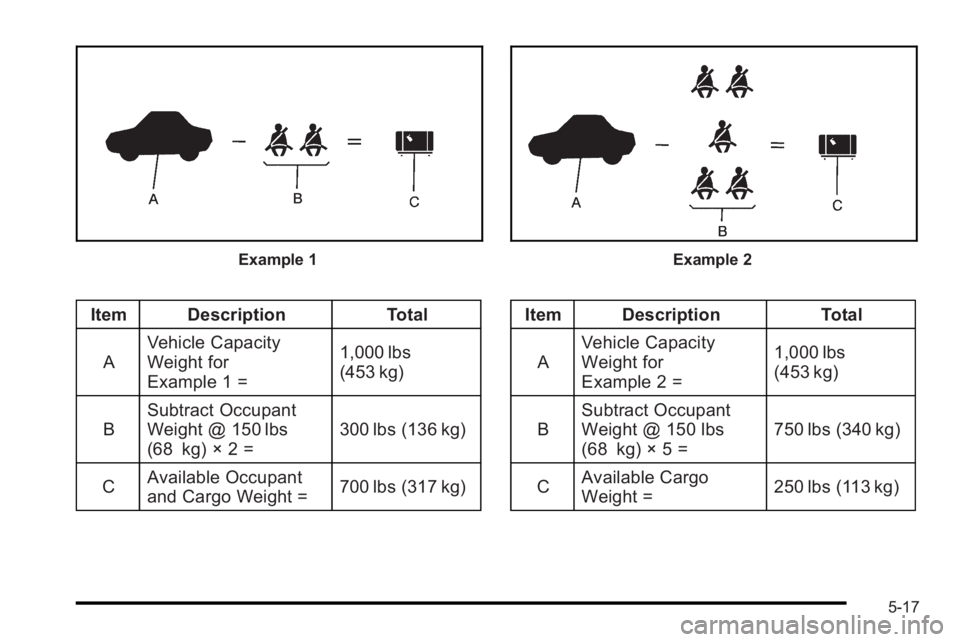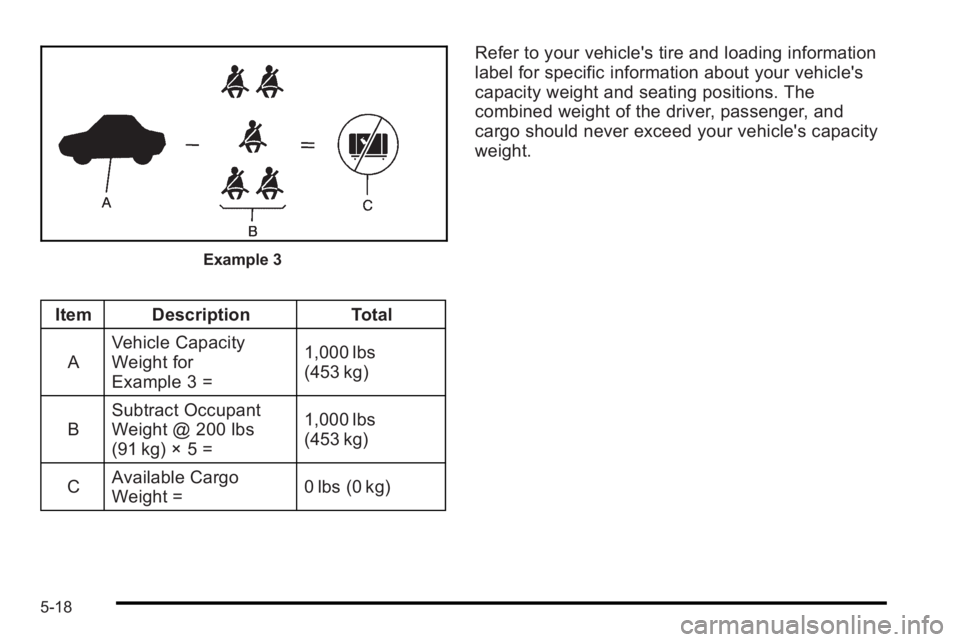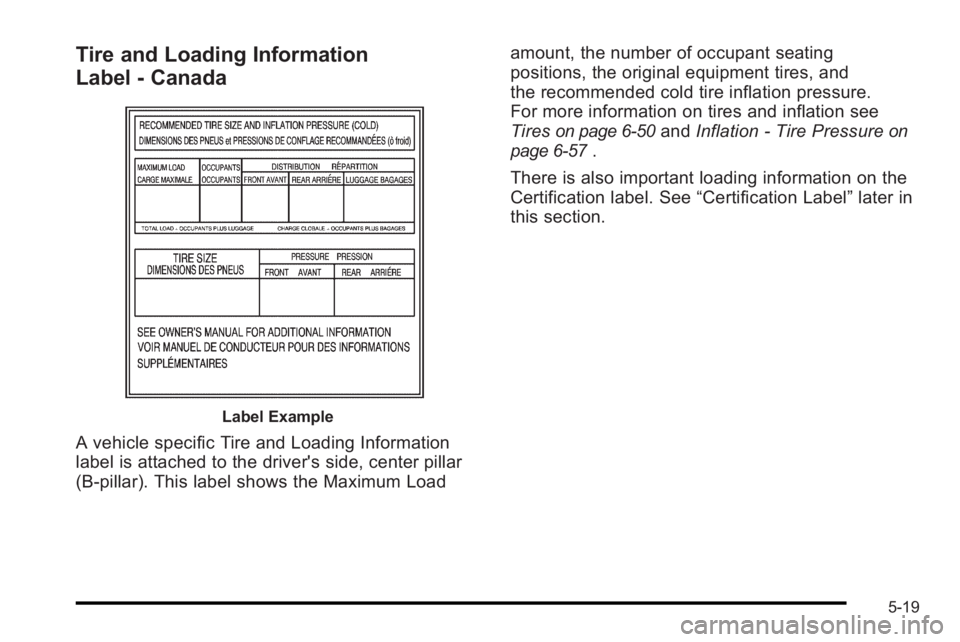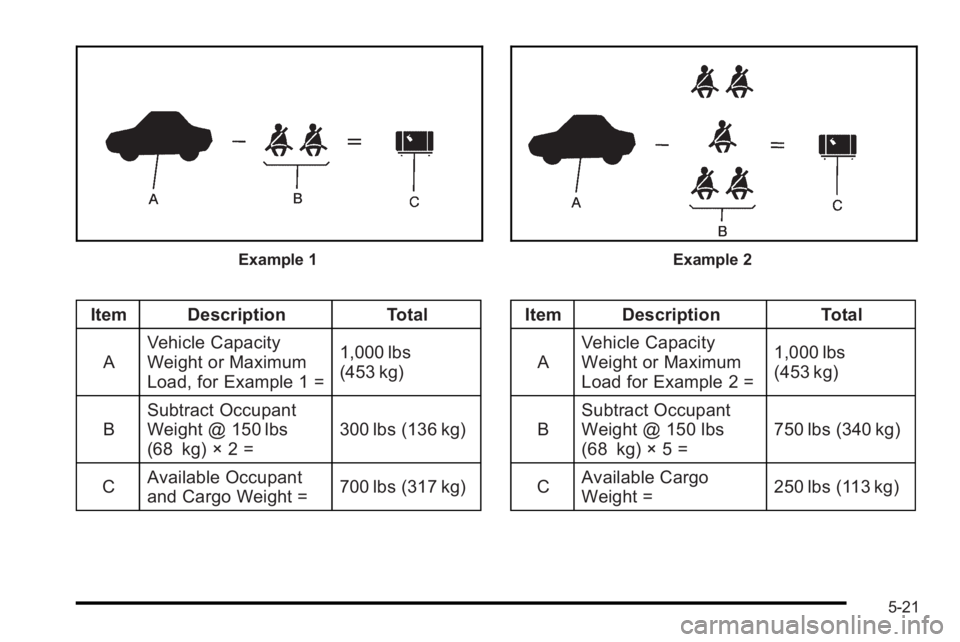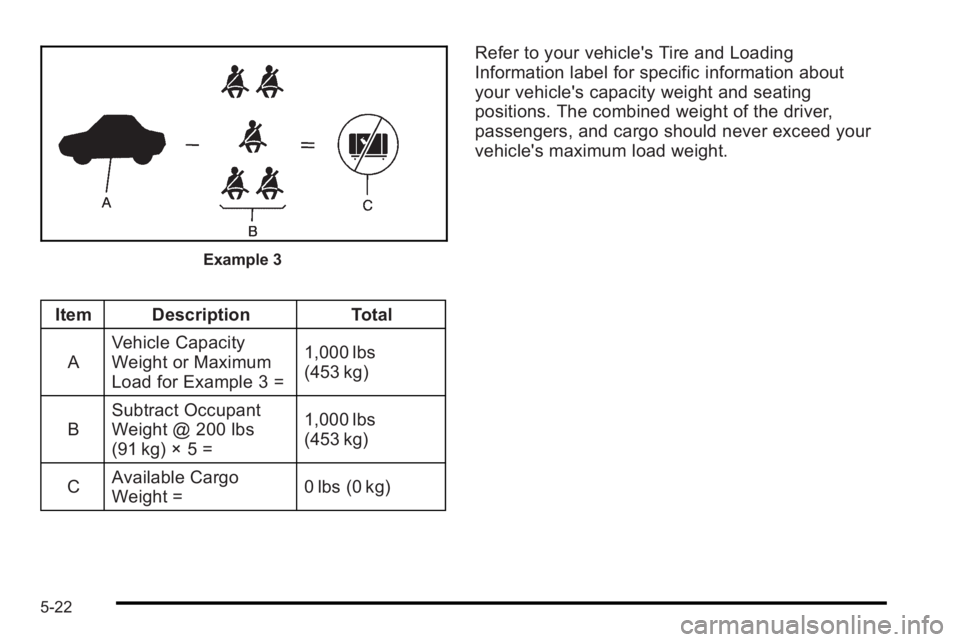PONTIAC G3 2010 Owners Manual
G3 2010
PONTIAC
PONTIAC
https://www.carmanualsonline.info/img/50/40815/w960_40815-0.png
PONTIAC G3 2010 Owners Manual
Trending: child seat, engine, radio, instrument panel, odometer, service, run flat
Page 211 of 368
Tire and Loading Information
Label‐United States
Label Example
A vehicle specific Tire and Loading Information
label is attached to the vehicle's center pillar
(B‐pillar). With the driver's door open, you will
find the label attached below the door lock
post (striker). The Tire and Loading Information
label shows the number of occupant seating
positions (A), and the maximum vehicle capacity
weight (B) in kilograms and pounds. The Tire and Loading Information label also
shows the tire size of the original equipment
tires (C) and the recommended cold tire inflation
pressures (D). For more information on tires and
inflation see
Tires
on page 6‑50andInflation - Tire
Pressure
on page 6‑57.
There is also important loading information on the
Certification label. See “Certification Label”later in
this section.
5-15
Page 212 of 368
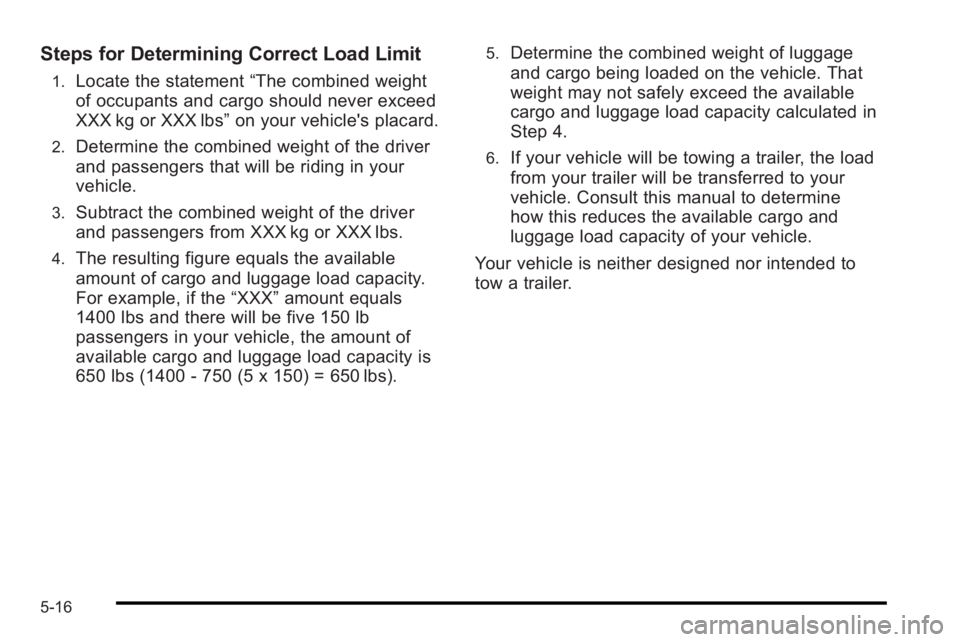
Steps for Determining Correct Load Limit
1.Locate the statement“The combined weight
of occupants and cargo should never exceed
XXX kg or XXX lbs” on your vehicle's placard.
2.Determine the combined weight of the driver
and passengers that will be riding in your
vehicle.
3.Subtract the combined weight of the driver
and passengers from XXX kg or XXX lbs.
4.The resulting figure equals the available
amount of cargo and luggage load capacity.
For example, if the“XXX”amount equals
1400 lbs and there will be five 150 lb
passengers in your vehicle, the amount of
available cargo and luggage load capacity is
650 lbs (1400 ‐750 (5 x 150) = 650 lbs).
5.Determine the combined weight of luggage
and cargo being loaded on the vehicle. That
weight may not safely exceed the available
cargo and luggage load capacity calculated in
Step 4.
6.If your vehicle will be towing a trailer, the load
from your trailer will be transferred to your
vehicle. Consult this manual to determine
how this reduces the available cargo and
luggage load capacity of your vehicle.
Your vehicle is neither designed nor intended to
tow a trailer.
5-16
Page 213 of 368
Example 1
Item DescriptionTotal
A Vehicle Capacity
Weight for
Example 1 = 1,000 lbs
(453 kg)
B Subtract Occupant
Weight @ 150 lbs
(68 kg) × 2 = 300 lbs (136 kg)
C Available Occupant
and Cargo Weight = 700 lbs (317 kg)
Example 2
Item Description
Total
A Vehicle Capacity
Weight for
Example 2 = 1,000 lbs
(453 kg)
B Subtract Occupant
Weight @ 150 lbs
(68 kg) × 5 = 750 lbs (340 kg)
C Available Cargo
Weight = 250 lbs (113 kg)
5-17
Page 214 of 368
Example 3
Item DescriptionTotal
A Vehicle Capacity
Weight for
Example 3 = 1,000 lbs
(453 kg)
B Subtract Occupant
Weight @ 200 lbs
(91 kg) × 5 = 1,000 lbs
(453 kg)
C Available Cargo
Weight = 0 lbs (0 kg)Refer to your vehicle's tire and loading information
label for specific information about your vehicle's
capacity weight and seating positions. The
combined weight of the driver, passenger, and
cargo should never exceed your vehicle's capacity
weight.
5-18
Page 215 of 368
Tire and Loading Information
Label‐Canada
Label Example
A vehicle specific Tire and Loading Information
label is attached to the driver's side, center pillar
(B‐pillar). This label shows the Maximum Load amount, the number of occupant seating
positions, the original equipment tires, and
the recommended cold tire inflation pressure.
For more information on tires and inflation see
Tires
on page 6‑50and
Inflation - Tire Pressureon
page 6‑57
.
There is also important loading information on the
Certification label. See “Certification Label”later in
this section.
5-19
Page 216 of 368
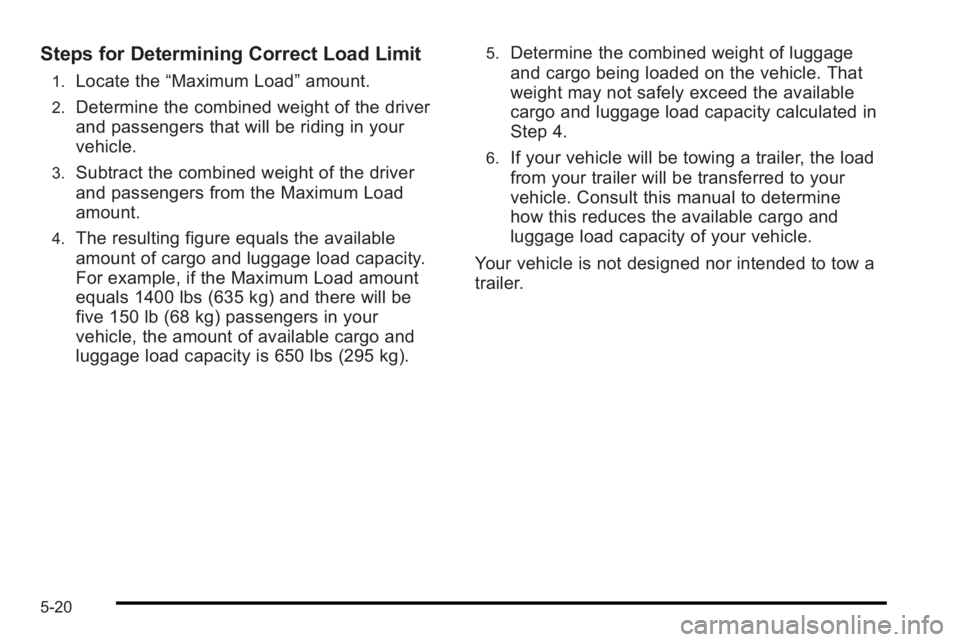
Steps for Determining Correct Load Limit
1.Locate the“Maximum Load” amount.
2.Determine the combined weight of the driver
and passengers that will be riding in your
vehicle.
3.Subtract the combined weight of the driver
and passengers from the Maximum Load
amount.
4.The resulting figure equals the available
amount of cargo and luggage load capacity.
For example, if the Maximum Load amount
equals 1400 lbs (635 kg) and there will be
five 150 lb (68 kg) passengers in your
vehicle, the amount of available cargo and
luggage load capacity is 650 lbs (295 kg).
5.Determine the combined weight of luggage
and cargo being loaded on the vehicle. That
weight may not safely exceed the available
cargo and luggage load capacity calculated in
Step 4.
6.If your vehicle will be towing a trailer, the load
from your trailer will be transferred to your
vehicle. Consult this manual to determine
how this reduces the available cargo and
luggage load capacity of your vehicle.
Your vehicle is not designed nor intended to tow a
trailer.
5-20
Page 217 of 368
Example 1
Item DescriptionTotal
A Vehicle Capacity
Weight or Maximum
Load, for Example 1 = 1,000 lbs
(453 kg)
B Subtract Occupant
Weight @ 150 lbs
(68 kg) × 2 = 300 lbs (136 kg)
C Available Occupant
and Cargo Weight = 700 lbs (317 kg)
Example 2
Item Description
Total
A Vehicle Capacity
Weight or Maximum
Load for Example 2 = 1,000 lbs
(453 kg)
B Subtract Occupant
Weight @ 150 lbs
(68 kg) × 5 = 750 lbs (340 kg)
C Available Cargo
Weight = 250 lbs (113 kg)
5-21
Page 218 of 368
Example 3
Item DescriptionTotal
A Vehicle Capacity
Weight or Maximum
Load for Example 3 = 1,000 lbs
(453 kg)
B Subtract Occupant
Weight @ 200 lbs
(91 kg) × 5 = 1,000 lbs
(453 kg)
C Available Cargo
Weight = 0 lbs (0 kg)Refer to your vehicle's Tire and Loading
Information label for specific information about
your vehicle's capacity weight and seating
positions. The combined weight of the driver,
passengers, and cargo should never exceed your
vehicle's maximum load weight.
5-22
Page 219 of 368
Certification Label
Label Example‐United States
Label Example ‐Canada
A vehicle specific Certification label is attached to
the center pillar (B‐pillar), below the driver's door
latch. This label tells you the gross weight
capacity of your vehicle, called the Gross Vehicle
Weight Rating (GVWR). The GVWR includes the
weight of the vehicle, all occupants, fuel and
cargo. Never exceed the GVWR for your vehicle,
or the Gross Axle Weight Rating (GAWR) for
either the front or rear axle.
5-23
Page 220 of 368
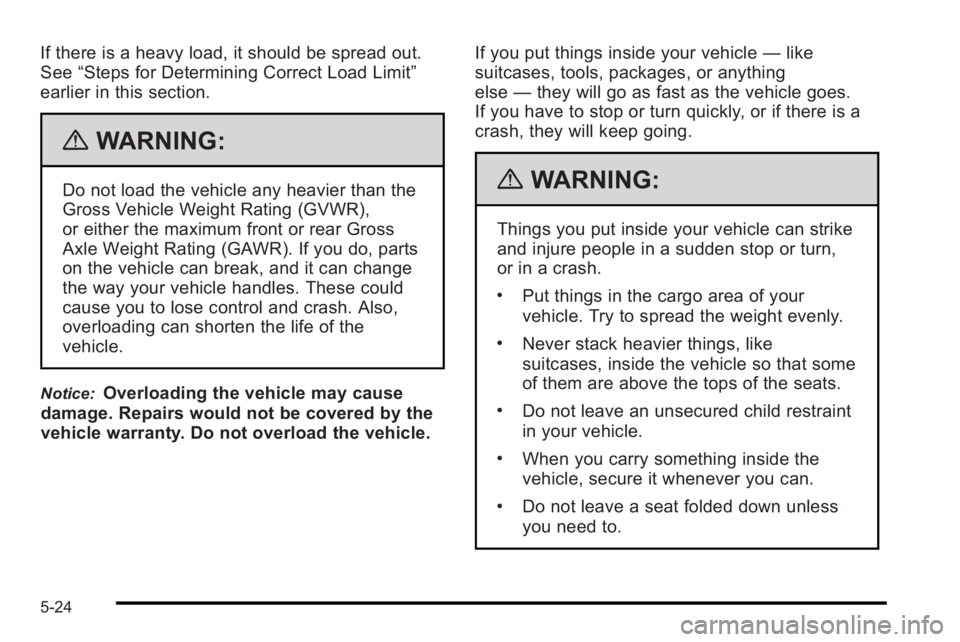
If there is a heavy load, it should be spread out.
See“Steps for Determining Correct Load Limit”
earlier in this section.
{WARNING:
Do not load the vehicle any heavier than the
Gross Vehicle Weight Rating (GVWR),
or either the maximum front or rear Gross
Axle Weight Rating (GAWR). If you do, parts
on the vehicle can break, and it can change
the way your vehicle handles. These could
cause you to lose control and crash. Also,
overloading can shorten the life of the
vehicle.
Notice:Overloading the vehicle may cause
damage. Repairs would not be covered by the
vehicle warranty. Do not overload the vehicle. If you put things inside your vehicle
—like
suitcases, tools, packages, or anything
else —they will go as fast as the vehicle goes.
If you have to stop or turn quickly, or if there is a
crash, they will keep going.
{WARNING:
Things you put inside your vehicle can strike
and injure people in a sudden stop or turn,
or in a crash.
.Put things in the cargo area of your
vehicle. Try to spread the weight evenly.
.Never stack heavier things, like
suitcases, inside the vehicle so that some
of them are above the tops of the seats.
.Do not leave an unsecured child restraint
in your vehicle.
.When you carry something inside the
vehicle, secure it whenever you can.
.Do not leave a seat folded down unless
you need to.
5-24
Trending: cooling, tire pressure reset, fuel cap, instrument panel, oil additives, wiper size, fog light


